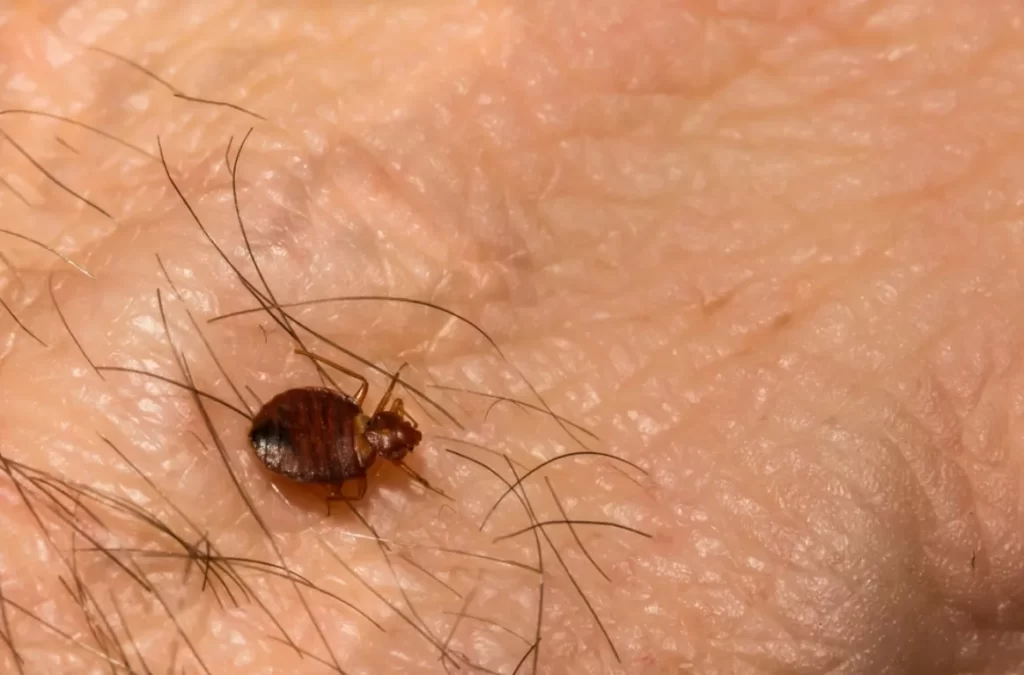Can bed bugs live in our clothes or car? Bedbugs are creepy animals that hide in cracks, tiny holes, crevices, and folds only to come out and feed on your blood when you are asleep.
Sometimes they may not wait for you to switch off the lights and crawl towards you for a blood meal. So long as you spend some time near hungry bedbugs, they will dare to come for a bite before crawling out of sight.
These are not the kind of bugs you need in your house. Sometimes you won’t know they live in your house or bed until you begin waking up with blood spots on your sheets. How do these creepy bugs find their way into your house?
Seite Inhalt
Can Bed Bugs Live in Your Ear?
Yes, bed bugs could crawl into and try to make themselves comfortable in your ear but in very rare occasions. Otherwise, they would pounce on a chance to live in your ear the moment they find it available.
Conditions in the ear look like what a Bettwanze would like. The dark and maze-like ear makes it a perfect environment to live and lay eggs. Bettwanzen have been found in people’s ears before.
However, the chances are that if you wake up, the uneasy feeling you will have in your ear will push you to try and remove it or visit your doctor to remove the bug hiding in your inner ear.
FAQs on Where Bed Bugs Live
Do Bed Bugs Come from Outside?
If you do not have bedbugs hidden somewhere in your house clutter, then they will have to come from outside if they are to find a way into your house.
Bettwanzen cannot fly as a housefly would. Therefore the only way they would have to get in your house is in two basic ways.
Crawling into your house
This is very unlikely because the furthest a bed bug can make it on its tiny legs is 100ft, that is assuming the path is clear, and the conditions outside are favorable.
This scenario is highly unlikely. However, if you live within a few feet from your neighbor’s house or live in an apartment, then Bettwanzen can have an easy time coming into your home.
Hitchhiking
This is technically the de facto way a Bettwanze would get in your house. The physical qualities of a bug make it one of the most “undercover” hitchhikers you could find in the insect world.
Talk of a flattened body that can slip into a fold, the tiny size, the ability to camouflage on darker surfaces, the ability to go without a blood meal for half a year, and the list goes on.
Either you or someone else could mistakenly transport a bug from somewhere else in a bag, a purse, furniture, clothes, or even shoes.
Once they reach your house, they make themselves comfortable and launch a bite attack when hunger calls and quickly return into hiding.
Can Bed Bugs live in Your Clothes?
Bettwanzen are good at hiding virtually anywhere, and your clothes look like a perfect place for them to hide and go undetected, that is if you are not putting them on. These bugs also need some aspect of peace.
They do not like to be disturbed by heat or vibrations which makes them uneasy. If a bedbug had been hiding away in your clothes, for instance under the collar or beneath those folds that make your dress stand out they might come out later.

They will only live in your clothes if they are hanging or sitting somewhere stationary without you in them. A new research study also suggests that bed bugs may be attracted to dirty laundry.
This further supports the findings of another research study that states that bed bugs can undergo the full reproductive cycle while on the patients’ clothes thereby resulting in significant anemia.
If you have a persistent bed bug infestation on your clothes, you may consider using bed bug laundry detergents as well as using the best steamers as part of the whole-house heat treatment.
RELATED: Can bed bugs live in your hair all day?
Can Bed Bugs live in Your Car?
Can bed bugs live in your car or trunk in the summer? Bettwanzen love clutter, disorganization, dark spots, cracks, small holes, crevices, folds, obstructed surfaces, depressions, and all those places that are inaccessible.
Some of the spots and objects that offer this kind of hiddenness are box springs, couches, mattresses, bed frames, appliances, and so forth.
But most importantly, beg bugs like to live near you because you are the source of food. They do not live further than six feet from you because you are the one carrying their meal.
Just the way a car is arranged provides a hoard of hiding spots that you probably cannot exhaust.
Bed bugs love such a maze of dark hidden places where they can create a base and launch attacks when you are unaware. So yes, Bettwanzen can live comfortably in your car, and probably you will never find out.
Can Bed Bugs Live on Your Body or Skin?
Bettwanzen have earned themselves quite a negative reputation among the human population. They are bugs that stay out of sight, creep on you at night, and suck your blood until they change color from a golden brown to almost black because of the blood.
However, without being carried away, they are bugs and not some skin-burrowing creatures. Researchers have come to agree that Bettwanzen do not like body heat at all.
Otherwise, they would stick on you like ticks, fleas, and lice do. Therefore they cannot spend time on your body much more than is necessary and definitely cannot live inside your body.
Otherwise, they would be some life-threatening animals that deserve to be annihilated when a chance presents itself. Two more myths that need debunking are whether Bettwanzen can survive out of bed or whether they can dare the cold outside.
Can Bed Bugs Live Outside of the Bed?
By the sound of it, it appears Bettwanzen were meant to be bedridden. They are bugs that can only be found in beds or bugs that cannot survive outside the bed.
If we can step back a bit, Bettwanzen are attracted to you and not the bed. They inhabit the bed because it is the only place in your house where you will spend many hours while inactive and literally asleep and unaware.
The bugs will not have to worry about you killing them or feeling pain when they bite your skin to suck some supper out.
However, these bugs can live comfortably outside of the bed. Would you like to know some of the common places where you can find bed bugs other than your bed?
- Curtains: A perfect spot with many hidden folds just like bedbugs like them. It is less likely that you would notice them and try to spray them off if they are at the back of the curtain or hidden somewhere in the seam.
- Luggage: your luggage has many hidden surfaces and pockets that provide a safe haven for bed bugs to hide. They will most likely hitch a hike on your luggage from somewhere else into your house.
- Clutter: The ideal place you would likely find bed bugs is on hidden surfaces that are near where you frequent. You will likely not find them in the garage but you will find them in that disorganized heap of papers and other material by your bedside or your sitting room.
- Furniture: Bed bugs love the tight spaces you find in furniture, for instance between two joints. They are flat enough to squeeze themselves in very tight corners and joints. They love such spots because there are very few chances you will make any endeavors trying to look for anything in such areas.
Can Bed Bugs Live Outside in the Cold?
Bettwanzen are some of the hardest bugs you can find. For instance, nymphs can survive without a blood meal for weeks while adults can go for six months.
The bad news is that Bettwanzen can survive the cold, even though with limits. They are not as tolerant of cold temperatures as we all would think.
Science has proven that live Bettwanzen can survive in temperatures of -25 degrees Celsius for a few hours. They can survive a temperature of -16 degrees Celsius for up to 80 hours.
So you may still be in danger even with frozen temperatures outside. If one crawls in the cold and finds your house as a refuge, then you may be facing a tough battle ahead. Bedbugs reproduce really fast.
READ MORE:
- Wo kann ich Bettwanzenbomben kaufen? - 30. Januar 2023
- Wo kann ich ein Mittel zur Bekämpfung von Bettwanzen kaufen? - 30. Januar 2023
- Wo kann ich Bettwanzenspray kaufen? - 30. Januar 2023
